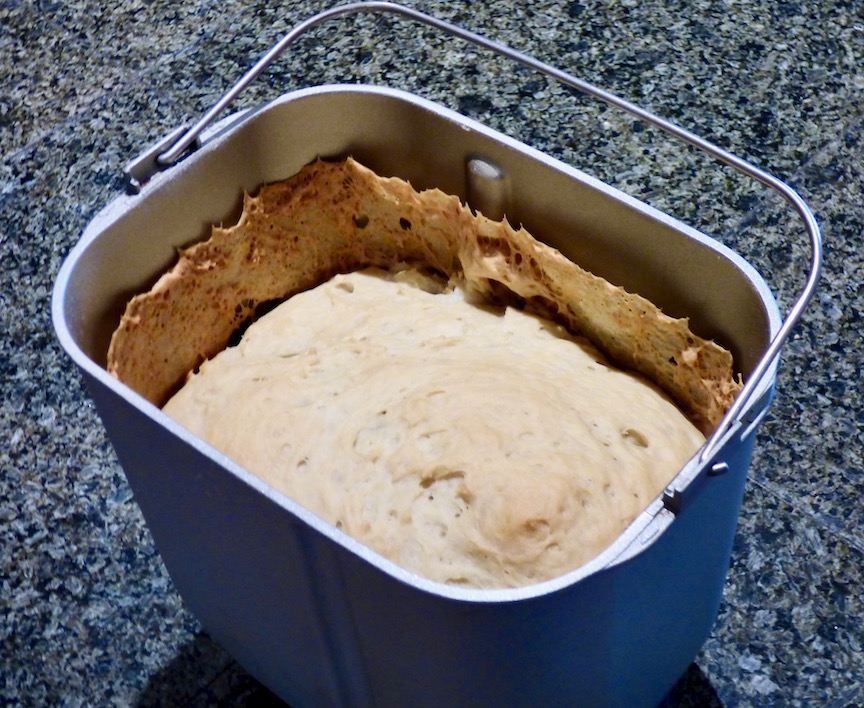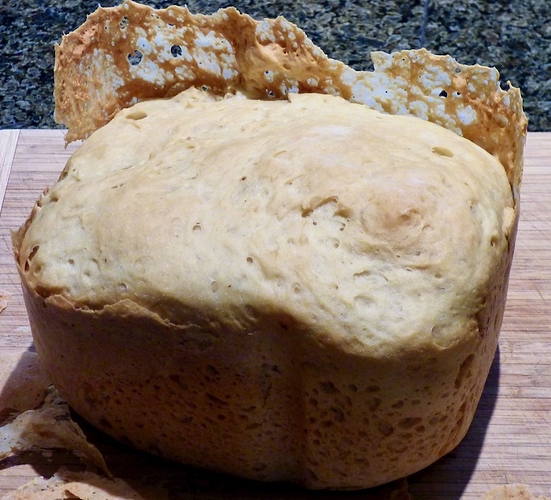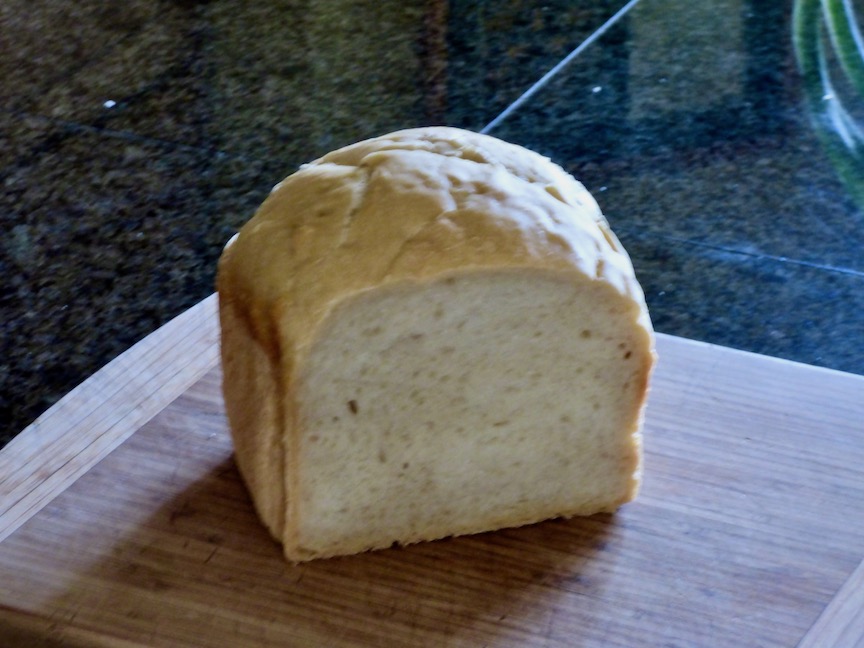Looks like the dough was too wet. The change of flour could explain that. Possibly also over fermented or over proofed due to a change of weather. Is it warmer?
Dough looked just right on a 10-minute check into the kneading cycle. We keep 72F in the house daytime, drops into the 60s when the furnace is off at night. My last starter was made with whole wheat flour. This time around I used all-purpose flour to make the starter and the levain was nice and spongy with plenty of air bubbles and some of that brown liquid after a week of feeding. Used 250 grams before adding the rest of the water, flour, salt and butter/or/oil. Don’t really know the difference between bread flour and all-purpose flour but that could be it.
Bread flour is stronger and would probably suit higher hydration
Which bread flour did you use for when the recipe worked. And which AP flour are you using now?
Gold Medal bread flour worked best last time. AP flour this time was King Arthur. Hydration continues to puzzle me because some online mavens say mature fed starter should be spongy and pokeable with a finger while others say it should have the consistency of thick, pourable pancake batter. And what does a cup of dry or spongy starter or levain weigh in grams compared to the thick batter type?
Let me see… (Just googling…)
Gold Medal Bread Flour is 12.2 - 12.7% protein
King Arthur AP Flour is 11.7% protein
Not a huge difference. But having said that it does look like the flour was too hydrated so perhaps it might fait better with a bit less water.
Now everyone has their own way of keeping their starter from flour to hydration and how its maintained. A starter can be a piece of dough to a thin batter and everything in between. And using cups to boot will make things worse. Did the person who made the recipe have a 100% hydration bread flour? Did they stir of down before measuring a cup? The margin for error is quite big. However if you weigh everything and someone gives you the hydration and flour used in their starter then the margin for error is much smaller.
And there’s the rub. Starters vary wildly from wet to dry and weights vary wildly from 100% hydration to 65% and none seem to take that distrinction into account. I used less hydration last attempt and got a crust that needed a pickax to penetrate. More hydration and I get the consistency of a brick. My French bread has always been light and airy and maybe I should stick to that
If a recipe calls for 150g bread flour starter at 100% hydration then you know exactly how much flour and water is in the starter - 75g water + 75g flour.
If a recipe calls for one cup of 100% hydration bread flour starter then this is more inaccurate. Most will say stir the starter down before measuring for accuracy.
If a recipe just says 1 cup of starter then even more inaccurate.
So knowing the flour, hydration and weight will help to ensure best results. Often recipes call for a levain build as this will put everyone on the same footing by the time they start the main dough. In other words they’ve taken this into consideration. Everyone has a different starter so if everyone takes a small bit if their starter and gives it a feed according to the recipe then this brings everyone into tandem.
Starting off with a small amount of starter won’t be a problem when building a larger amount of off shoot starter, a levain, that goes into the dough.
Indeed if a recipe calls for a small amount of starter and a long ferment then don’t sweat it as it won’t make much difference.
A recipe all in cups, especially one which you can’t alter by feel as you go along i.e. in a bread machine, will result in widely varied degrees of success.
Which recipe are you following?
I only go by weight in grams, not volume in cups. That said, I’ve been experimenting with variants of your recipe in a 4-hour basic bake cycle – 418g flour, 8g salt, 14g butter or oil, 310g water – with 250g of levain or starter ranging from thick pourable batter to relatively dry and spongy. Tried some with one tbs of sugar because some said it improves the rise but it didn’t so gave up on that. Also tried it with or without a tbs of bead machine yeast for the same reason with no noticeable difference in result. The wetter starter collapsed after the rise. The dryer starter produced a really hard crust. Both loaves, while edible, were heavier and more dense than store-bought sourdough or my llight and airy French bread made in the same machine.
I might add that I tried two different batches of starter, one bought dry from Breadtopia and fed for 8 days with white flour before use, and another I made myself with whole wheat flour (couldn’t find any rye flour in my neck of the woods) which smelt and tasted a lot more sour than Breadtopia’s. The latter also made teriffic hotcakes.
Your machine’s recipes are carefully crafted for yeasted recipes. Sourdough will take trial and error. The recipe I gave you, or rather the method, works for the Panasonic sd2500 and sd2501. Obviously its not suiting your machine. Back to the drawing board. I suggest make a loaf or two of French bread as its good to get some success to be able to keep going. Then we can return to the sourdough for another trial. In the meantime I’ll have a look at the recipes and see if I can come up with something.
With all due respect to everybody who’s been playing this game a lot longer than me…
Trust me when I tell you… dump the bread machine, start making it by hand. It’s actually quite fun, I’ve engage in my two sons who are needing, stretching and pulling and mixing, and really enjoying it… My 12-year-old especially enjoys it!
I just stretched and folded a loaf it will prove for about 3 1/2 hours, outputted my pan and will come out to be a gorgeous beautiful young meat loaf of bread…
We gave out because the bread machine does not proof properly especially when you use the cheapest one like we did.
The same thing happened to me when I first tried sourdough in my bread machine. I had overproofed it by using yeast along with my starter. When I cut out the yeast, the problem was solved.
Keep in mind that amount of starter is inversely proportional to time required for fermentation and resultant leavening. It seems to me that 250g is a lot of starter for typical cycles in a bread machine of that size, which likely led to over-proofing and collapse. There’s nothing wrong with that quantity of starter, but where a machine fixes the time cycle you may have needed to reduce the amount of starter (or, if programmable in your machine, the time of fermentation). You could quickly home in on perfection for a set quantity of starter by letting the machine handle the mixing and kneading and removing the dough after kneading for a carefully timed manual finish, observing the rise closely and judging when it is just right. If you do this with the intention of programming a precise rising time into the machine, shape your test loaf in the general proportions of the machine’s kettle as it rises for accuracy. You also may find that doing this produces a loaf so much more pleasing qualities than the machine does that you’ll adopt the technique.
Thanks to all for the helpful advice, tips and critiques. First, I bow to the wisdom of those who say sourdough bread should be baked in Dutch oven rather than a bread machine, especially one that does not have a sourdough setting or adjustable cycles. I plead guilty to (1) laziness (2) arthritic wrists that can no longer knead and (3) the American reliance on machine over method. Next I agree with on the over-proofing argument, i.e. the levain does not need added yeast. Lastly, I will continue with my experiments because it makes my house smell good and the starter produces killer sourdough pancakes smothered in melted butter with homemade raspberry syrup canned with a dollop of port wine.
Makes me absolutely CRAZY…everyone loves this simplistic recipe - I have 2 bread machines: Zojirushi (named in recipe) and Panasonic…always turns out great - AP or bread flour.
Just make sure you do the first part…
Sourdough starter, water, yeast, and sugar in pan…stir gently and sit for 10 minutes…
Then scatter 360 grams flour evenly over liquid ingredients…lastly sprinkle the salt and oil. Set as desired… BASIC is fine and I actually programmed my Zojirushi as the recipe gives in detail… did not care for the result!
Let me know please! Or if you have any questions…perfect way to use a LOT of starter in a recipe. NO fermentation…just the run through of the cycles.
You look talented…but it’s the recipe!
Hello! Hope my two cents worth may help. I also use a bread machine BUT only for the kneading on Dough setting.When the dough cycle is done, I carefully slide the the dough (I don’t reshape it again because I find sourdough doesn’t rise as well after reshaping) into a greased oven proof bowl, place it in a large plastic bag and HERE is the trick…refrigerate the dough overnight for a cold, slow rise. Here is a another hint I got off a bag of flour, add 1 TBSP bottled lemon juice to your liquid in the dough recipe it is magical and gives the bread great lift too. This is my bread machine kneaded sourdough out of the oven this morning:
I’m pretty well decided on Raydee8’s Best Bread Machine Sourdough as the recipe most likely to succeed in a bread machine without resorting to hand kneading or dough only in machine and bake in oven cycles, but I’m still unsure of weights as opposed to volume of ingredients. What should the starter weigh in grams, as opposed to cups or ounces, and is it a wet runny starter, or a dry spongy starter, or heavy like a pancake mix. Thos weights vary hugely. Also, some say add the yeast, others say leave it out because real sourdough just needs the levain. And lastly, is it necessary to refrigerate overnight for a slow rise (only to see it fall the next day), or does that just prolong the agony? To give myself a whiff of success after multiple failures I made another loaf of French bread in my Panasonic and it was so damn good it was half eaten before it even cooled. Wish I could say the same for my sourdough.
Pictures attached.Bread machines are best designed for yeasted breads as yeast more predictable and therefore better designed for baking “by the clock”. Sourdough, IMO, is a better tasting bread but its more, or even solely, watching the dough and not the clock.
Now while its more difficult to get the perfect sourdough out if a bread machine its not impossible. Just takes trial and error with tweaks here and there to get a lovely loaf out of it. However it helps to understand sourdough and baking with it before you experiment in a breadmaker. If you dough collapses on a cycle then choose a shorter cycle or less starter. If its too dense then you need more water etc.
My friend gets a lovely loaf so its not impossible.




